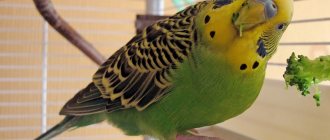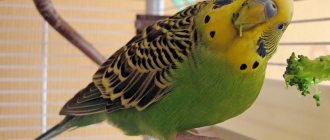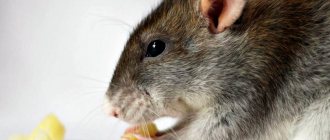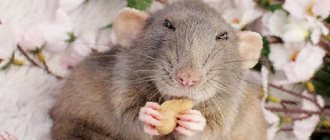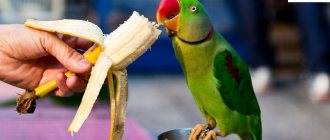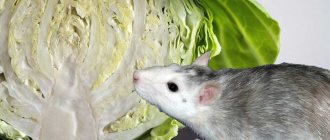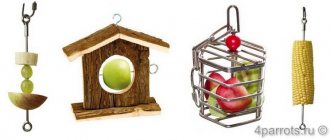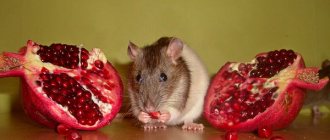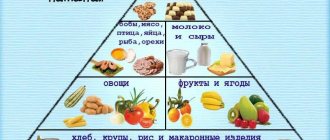The rat is an amazing pet that everyone in the household loves, so they try to prolong its life as much as possible. The basis for a pet’s good health is proper living conditions and a nutritious diet.
Not everyone thinks about what to feed a rat correctly. It is generally accepted that it is omnivorous and indestructible; it can easily eat even a piece of cardboard or sawdust. In most situations, rat owners go in two ways: either they feed the rat like a hamster, or they give away table scraps. Both of these approaches are wrong.
In fact, feeding a rat correctly is not difficult. You need to choose only healthy foods and give her the right amount of proteins, fats and carbohydrates.
Fruit seeds and seeds
One of the prohibited foods is fruit seeds. In particular, the seeds and kernels of citrus fruits contain the toxic substance amygdalin. When it breaks down, hydrocyanic acid is released. One bone contains enough poison to kill the animal. Do not feed your rat seeds and pits of plums, apples, peach, oranges, cherries, lemons and other fruits. Rapeseed and mustard seeds are prohibited for consumption. It is allowed to feed your pets watermelon, sunflower and pumpkin seeds. They are used as a supplement to main food. An overdose of seeds can cause serious poisoning.
Healthy foods for rats
In order for your pet to feel good and develop normally, it is necessary to feed it high-quality food from the first days of life. The benefits of a properly selected diet can hardly be overestimated. By receiving natural, balanced nutrition, your pet will grow healthy and active, and its coat will be shiny and pleasant to the touch.
Cereals and grains
Cereals and grains are an integral part of the rat menu. Cereals are rich in carbohydrates, which provide sufficient energy, and proteins, which are the main building material for all cells of the body. The following foods are considered the most beneficial for rats:
- Wheat forms the basis of the diet of rats. It consists of 70-75% carbohydrates, so it saturates the body with energy for a long time. It is a natural source of vitamins A, B, C, E, K and minerals (potassium, sodium, calcium, iron, zinc, magnesium), which help strengthen the immune system, accelerate metabolism, and also prevent the development of diseases of the cardiovascular system. The digestive fiber contained in wheat normalizes the functioning of the gastrointestinal tract.
- Buckwheat is a lower-calorie cereal that is almost completely absorbed by the body. Rich in calcium, zinc, cobalt, iodine, iron. Increases endurance and resistance to disease. Thanks to the powerful vitamin composition: E, B1, B2, PP, folic acid - improves hematopoiesis, stimulates blood circulation, acts as a prevention of atherosclerosis, hypertension, anemia.
- Corn - corn grains contain a large amount of ascorbic acid, which increases metabolism in animals. Corn is also rich in calcium, iron, sodium, and magnesium. This composition helps strengthen the musculoskeletal system, normalizes the functioning of the heart and blood vessels, and stimulates mental activity. 100 grams of product contains 337 kcal. Adding corn to a rat's diet promotes rapid satiety.
- Oats - contain a lot of fiber, so its regular consumption improves intestinal motility and promotes timely cleansing of the body. Rich in B vitamins, calcium, iron, phosphorus. Oats also contain a lot of protein and carbohydrates, so the rat feels a strong boost of energy after a meal.
- Brown rice contains a sufficient amount of fats and amino acids. Vitamins B, E, K, PP contribute to the activation of metabolic processes. Microelements (iodine, magnesium, calcium, selenium, phosphorus, zinc, copper) protect internal organs from diseases. Brown rice contains antioxidants that prevent the formation of toxic compounds in the body. The product is also completely hypoallergenic.
Many rat owners try to feed their pets semolina, citing its high nutritional value. However, this is not the best option - semolina does not contain beneficial substances for the rat, so consuming it will only lead to the rodent gaining excess body weight.
All rats are predisposed to the development of tumor diseases. The rich vitamin and mineral complex contained in buckwheat reduces the development of malignant tumors in rats by 40-50%.
Juicy food
Food of plant origin should be present in the rat’s menu daily, in the amount of 10-12 grams. Juicy food is very useful for rodents, since plants are irreplaceable sources of vitamins, micro- and macroelements. Permitted for use are:
- Carrots are allowed both raw and boiled. Just don’t give your fluffy too much treats to avoid diarrhea. Carrots contain a lot of vitamin C, protein and iron compounds. It is also an additional source of moisture.
- Pumpkin is one of the healthiest vegetables, containing a rich vitamin and mineral complex. The product should be offered to the animal in its raw form. Excessive consumption may lead to bloating.
- Zucchini is a dietary product that helps remove excess fluid from the body. Slows down the aging process, normalizes the functioning of the nervous system, strengthens the immune system. Zucchini helps the body digest heavier foods.
- Leaf salads . Eating them regularly will help remove harmful cholesterol from the rodent’s body and protect it from developing heart and vascular diseases. Green leaves also contain a lot of fiber, which helps improve the functioning of the gastrointestinal tract. Owners of hyperactive rats should know that salads have a mild calming effect on rodents.
- Greens (dill, parsley, celery) – suitable for daily feeding. Helps remove waste and toxins from the body, normalizes stomach acidity, and has an anti-inflammatory effect. It has a rich vitamin composition.
- Fruits . When introducing fruits into a rat's diet, it is necessary to take into account their acidity. The digestive system of rats does not digest acidic foods well. Products approved for rodents are: seasonal watermelons and melons, cherries, apples, peaches, and currants.
Among the permitted products of plant origin, cucumber occupies a special place. The vegetable is beneficial for the rat’s body: it contains fiber, has a diuretic and tonic effect. However, its use often causes gas and bloating in rats. Therefore, it is better to offer cucumbers to rats 1-2 times a week, 4-5 small pieces.
Food of animal origin
Products of animal origin are an irreplaceable source of protein, without which normal growth and development of decorative rats is impossible. However, it is quite heavy for the stomach of rodents. Therefore, when feeding animals, it is necessary to choose dishes of animal origin that have low fat content. Among the products allowed for decorative rats, the most useful are:
- Fermented milk products (ryazhenka, kefir, natural yogurt, cottage cheese), but their fat content should not exceed 4%. Such foods stimulate digestive processes and are also a source of pro- and prebiotics.
- Lean boiled meat is a source of protein, vitamins and iron. Beef is best; beef liver is also allowed. It is recommended to pamper rats with meat delicacies more than 3-4 times a week.
- Hard boiled eggs . It is allowed to offer to rodents once a week. Since rodents may be allergic to egg whites, the product must be introduced into the menu carefully, gradually increasing the dose.
- Dried mealworms and insects . Almost 100% composed of proteins. To give your rodent a treat, you don’t have to collect the bugs yourself; ready-made mixtures are sold in pet stores. The main thing is not to overdo it with the dosage. Rats are allowed 5 grams 1-3 times a week.
- Seafood (squid, shrimp, crab) are sources of protein and microelements and are rich in iodine. Rodents are served boiled, without salt or seasonings. It is allowed to give from 3 to 5 grams of the finished product per week.
Often, owners of decorative rats offer their pets cat food. In principle, this is not prohibited, but you should not overdo it. It is recommended to offer furry animals meat pads as a supplement to the main diet - 2-3 pieces per day.
Vegetables
Certain types of vegetables should not be included in your pet rat's diet:
- Vegetables from the Brassica family: turnips, radishes and radishes. They lead to increased gas formation in the intestines;
- any type of cabbage causes bloating in a rat;
- Potatoes contain a huge amount of starch, which is harmful to the rodent’s stomach due to difficulty in digestion. Tops and sprouts are harmful due to solanine;
- legumes (peas, beans, lentils and others) disrupt the functioning of the gastrointestinal tract. If the animal does not have digestive problems, it is allowed to give dried mung beans, chickpeas or peas.
- You should not feed your pet raw artichoke. Reduces pressure due to increased alkali levels;
- beets are allowed to be given only in small quantities. It has a laxative effect;
- Raw eggplants contain the toxic organic compound solanine. You can give the vegetable, previously peeled and boiled;
- It is undesirable to eat cucumbers. They cause stomach upset and diarrhea;
- animals should not eat tomatoes due to the oxalic acid content;
- garlic and onions irritate the gastric mucosa, because... contain biologically active substances phytoncides.
Protein in a rat's diet
A rat is not a rabbit or a guinea pig, it cannot thrive on a vegetarian diet, it is important for it to get protein. Adults are given protein food twice a week, and young animals twice as often. But moderation is important in this matter - an adult animal needs only 20 g at one time.
The rat can be given lean boiled meat, boiled eggs, fish, shrimp or squid. If you have several rats living at home, then you need to give them protein supplements individually, since they really love such food and can fight for it. As a result, someone will be oversaturated, and someone will not receive their norm.
If you give a rat an egg, boil it soft-boiled so that the rat does not choke on the boiled yolk. A quail egg can be given with the shell, the rat will peel it itself or eat it straight away.
The animal loves fish or seafood, but after eating it, its urine acquires an unpleasant odor.
Green food
A caring owner needs to monitor the consumption of greens by a pet rat. List of prohibited green food:
- bugs and horseradish contain substances harmful to animals - essential mustard oils;
- sorrel spinach are a source of oxalic acid, which is dangerous for the pet’s body;
- You can’t feed rhubarb to animals, because it causes disruption of the gastrointestinal tract;
- seaweed has a high iodine content.
Why you shouldn't feed your rat prohibited foods
Often, beginning rat breeders are not serious about selecting a specialized diet for their pet. They explain their carelessness by the fact that rodents are considered omnivores. However, this approach to organizing the rat menu can have serious consequences:
- Stomach problems - bloating, gas, diarrhea - when drinking fresh milk. This effect is explained by the lack in rats of the enzymes necessary to digest lactose.
- Diseases of the cardiovascular system - if the owner pampers the pet with fatty foods: pork, lard, fried potatoes, butter.
- Obesity - with regular consumption of chocolate, sweets and other sweets. The danger lies not so much in the sugar itself, but in getting used to it. Having tried sweet food once, your pet will demand the treat again.
- Lethal outcome - after eating plants that are poisonous to rats (lily of the valley, fern, tulip, daffodil). Therefore, rodent owners need to constantly monitor their pets so that they do not accidentally try flowers standing in a vase or growing in a pot.
It is also worth remembering that a rat that often eats prohibited foods will eventually refuse to eat the specialized food necessary to maintain the health of the rodent.
Fruits and berries
Citrus fruits are prohibited for consumption; they can cause an allergic reaction that can be fatal. The reason for this is increased acidity. In some cases, you can give a piece of ripe tangerine as a treat. It is not recommended to add grapes and pears to your pet's menu. They lead to digestive problems: increased gas formation or severe stomach upset. Apples and persimmons are a source of poisonous hydrocyanic acid and amygdalin glycoside.
Dried fruits are prohibited, because they cause fermentation in the intestines. Figs, cranberries, rowan berries, green bananas and pineapple should not be given. The rat should not eat plums due to the laxative effect. Chokeberry and bird chokeberry lead to constipation. Garden or forest berries are not produced depending on the acidity level. Melon and watermelon must be fed during the season, because... at this time the amount of nitrates decreases. Fruits and berries are not the main food of rodents. Their consumption on an empty stomach leads to digestive system disorders.
What fruits can you give to a rat?
Rats prefer sweet fruits. In addition, the high acid content in fruits can lead to digestive disorders. Experienced breeders recommend offering furry cats the following types of fruits:
- apple (seedless);
- pear;
- peach;
- banana;
- avocado (pulp only);
- apricot;
- melon;
- watermelon;
- mango;
- plums;
- pineapple – a little, due to the large amount of sugar;
- persimmon;
- figs (small portions);
- kiwi;
- cherry, sweet cherry.
It should be borne in mind that some fruits (pear, plum, apricot) can cause fermentation, flatulence, and diarrhea. Therefore, in order to avoid problems with the gastrointestinal tract, it is necessary to give these treats in doses. If no negative reactions are noted, you can slightly increase the portion.
Watermelon and melon pulp should be given with caution, since nitrates are often used when growing melons. These products must be purchased from trusted retail outlets.
Dried fruits are allowed as a treat (1-2 times a week). Rats will like raisins, dates, dried apricots, and prunes. Offering these treats should be done with caution as they can cause bloating and diarrhea.
When feeding a rat with fruit, you need to make sure that no seeds, for example, from cherries or apricots, get into the feeder. Because they are a real poison for rodents.
Milk products
When adding dairy products to a rat's diet, it is necessary to take into account a possible allergic reaction to lactose. It is not recommended to give milk in its pure form. New dairy products should be introduced gradually, and the pet's reaction should be monitored. Cheese, sour cream and cream are undesirable for animals to eat due to their high fat content. Fermented milk products with a fat content of more than 4% are prohibited. Rats cannot have condensed milk, because... it contains a large amount of sugar. It is not recommended to give dairy products with a long shelf life.
Diet composition
The basis of a domestic rat's diet is a grain mixture. It is better to choose a ready-made mixture than to create a menu yourself, adding ingredients in the correct percentage. Food can be given without restrictions; a rare rat will eat more than 30 g.
In addition to the grain mixture, it is necessary to add succulent feed to the diet. These are vegetables, herbs, fruits, salads. Protein should also be present in the diet. This is especially true during active growth, pregnancy or breastfeeding.
In addition, you can give your pet treats. These can be seeds, nuts, dried fruits. There should be a limited amount of treats in the diet; it is best to use them as rewards.
The diet looks something like this: grains (60%), vegetables and herbs (20%), meat and eggs (10%). The rest of the diet consists of fermented milk products and treats.
What to feed a little rat
A mother rat feeds her offspring with milk. However, there are times when she does not want to do this. In this case, responsibility for the life of the offspring will fall on the shoulders of the animal owner. To feed baby rats, you can purchase a lactating female at a pet store or feed the babies yourself.
To feed babies, you can use a pet milk replacer. Dry soy baby formula diluted with a small amount of goat's milk or condensed milk is also perfect.
Important! Liquid formula can be stored in the refrigerator for no longer than 12 hours.
The milk mixture will need to be warmed up a little. To feed your offspring, it is better to use an insulin syringe with an internal catheter at the tip. You can also take a pacifier made from pieces of cotton fabric.
After each meal, you should pour boiling water over the items. To avoid the development of enteritis in young animals, it is worth giving small rats a course of Biovestin.
Below you can find detailed information regarding the principle of feeding animals by week:
- In the first 7 days of a rodent's life, it is worth feeding them every 120 minutes. liquid diluted milk formula. Closer to the 7th day of life, it is worth diversifying the menu with milk formula, to which a small amount of dry ground grain feed has been added;
- in the second week, the mixture for rodents can be diluted to a consistency that will resemble liquid sour cream. You will need to drink the mixture every 3-4 hours;
- in the third week of life, you can pour the food mixed with the mixture into a bowl. From 23.00 to 6.00 you can not feed the offspring;
- At 4 weeks, animals can be switched to dry food. From the 30th day of life, rodents should be given food that is familiar to adults. If desired, rat pups can be fed milk until the end of the second month of life.
Babies will need to be given formula every 2 hours.
What menu should babies have? When choosing a diet for little rats over 4 weeks old, you should give preference to:
- dry grain;
- boiled chicken, turkey and fish fillets;
- cottage cheese;
- dill and cilantro;
- bananas;
- apples;
- wheat sprouts;
- oats;
- chicken egg yolks;
- boiled chicken and turkey liver.
Under no circumstances should children be allowed to indulge in:
- cucumbers;
- champignons;
- garlic and onions;
- tomatoes.
Note! When rat pups are fed milk by their mother, they can only be fed by the 21st day of life. It is best not to wean babies early from breastfeeding, which has a positive effect on strengthening the animal’s immunity.
Organizing the right diet for your beloved rodent is important; this will allow you to raise the animal healthy. It is important to give up the desire to pamper your four-legged friend with table scraps such as sweets and sausage, as this can provoke the development of various pathologies of internal organs.
Posts 1 page 40 of 200
Share12013-06-08 22:48:24
- Author: beliy_den
- Participant
- From: Donetsk
- Registered: 2010-09-14
- Invitations: 0
- Posts: 2526
- Female gender
- Age: 42 [1979-09-27]
- Time spent on the forum: 28 days 3 hours
- Last visit: 2016-01-22 19:53:14
somehow unexpectedly the previous topic ended. Feeding: do's and don'ts - 1
Share22013-06-09 18:02:44
- Author: Aunt Koka
- Participant
- From: Kharkov
- Registered: 2011-08-11
- Invitations: 0
- Posts: 378
- Female gender
- Spent on the forum: 6 days 20 hours
- Last visit: 2015-05-20 18:38:57
Can rats have mint? (I didn’t read the previous topic)
Share32013-06-09 18:58:04
- Author: Dunya
- Blocked
- From: Ukraine, Dnepropetrovsk
- Registered: 2012-06-21
- Invitations: 0
- Posts: 2065
- Female gender
- Age: 44 [1977-03-18]
- Time spent on the forum: 1 month 4 days
- Last visit: 2014-04-06 19:59:21
Can rats have mint? (I didn’t read the previous topic)
Can!! Need to. They are so fun to rub with mint. Especially the girls. They're kind of suffocating))
Share42013-06-09 21:21:48
- Author: Aunt Koka
- Participant
- From: Kharkov
- Registered: 2011-08-11
- Invitations: 0
- Posts: 378
- Female gender
- Spent on the forum: 6 days 20 hours
- Last visit: 2015-05-20 18:38:57
yeah, today I gave it (crap, I asked later), they came running to my arms and smelled so good.
Share52013-06-09 21:34:28
- Author: iren
- Participant
- From: Dnepropetrovsk
- Registered: 2012-11-12
- Invitations: 0
- Posts: 963
- Female gender
- Time spent on the forum: 22 days 15 hours
- Last visit: 2015-09-21 11:33:54
mine weren't appreciated
Share62013-06-09 22:11:20
- Author: markopolo83
- Moderator
- From: Donetsk
- Registered: 2012-05-30
- Invitations: 0
- Posts: 1422
- Female gender
- Age: 37 [1983-11-05]
- Spent on the forum: 1 month 8 days
- Last visit: 2019-11-07 16:00:52
Is it possible to give rats snails, which sometimes appear in abundance on our streets? Can they be a source of helminths? What about beetles, bronze beetles, for example?
Share72013-06-12 18:54:50
- Author: Vera777
- Participant
- From: Khmelnitsky
- Registered: 2013-03-15
- Invitations: 0
- Posts: 3370
- Female gender
- Age: 34 [1987-03-22]
- Spent on the forum: 1 month 3 days
- Last visit: 2018-09-01 15:54:26
I brewed dry echinacea, can I give it a leaf to chew?
Share82013-06-12 20:14:22
- Author: Diana
- Participant
- From: Vinnitsa
- Registered: 2011-10-18
- Invitations: 0
- Posts: 7056
- Female gender
- Age: 48 [1973-08-07]
- Spent on the forum: 2 months 28 days
- Last visit: 2020-08-15 08:52:08
Vera777 , you need to give it!)
Share92013-06-12 20:56:57
- Author: beliy_den
- Participant
- From: Donetsk
- Registered: 2010-09-14
- Invitations: 0
- Posts: 2526
- Female gender
- Age: 42 [1979-09-27]
- Time spent on the forum: 28 days 3 hours
- Last visit: 2016-01-22 19:53:14
Types of domestic rats
This type of animal differs in size, coat color, and spots on the body. The most popular varieties are:
- standard;
- rex;
- satin rat;
- tailless rat;
- sphinx;
- downy;
- dumbo.
Standard is one of the popular breeds of domestic rats. The species was created by crossing white and gray rats. The color of this breed can be pure white or black and white. In rare cases, tri-colored rodents are found, with the presence of brown or gray. The eye color of this breed can be black, red or ruby. Adult rats have a maximum weight of 500 grams and reach a length of up to 20 cm.
The Rex is a unique species that has a coarse, curly coat. In addition to fur, this breed also has curly mustaches.
The satin rat is also called satin rat. Her fur is long, soft and shiny.
Tailless rats (Manx rats) are distinguished by the absence of hair on their tail.
Sphynx cats are very suitable for exotic lovers and those who do not like wool. Their lifespan is shorter than that of other species. Sphynx cats are highly susceptible to infectious diseases, which is why they require special care.
The downy rat has fine down, slightly curly whiskers, and may have hairless areas on its body.
Dumbo rats are distinguished by their large, rounded ears and may have similarities with other species. This could be a curly coat or no coat at all. The color of the coat can also be different.
Table of permitted and prohibited products
Above are only the main foods that can and cannot be given to a rat. However, the list of permitted and prohibited foods is much wider. For clarity, the main product groups are grouped in the table.
| Category | Can | Rarely | It is forbidden |
| Cereals | Buckwheat, millet, wheat, brown rice, barley, rye, flax seeds | Corn, oats, couscous | Semolina |
| Vegetables | Zucchini, pumpkin, Chinese cabbage | Cucumber, carrots, bell pepper, beets, tomato, broccoli, garlic, onion | Beans, peas, white cabbage, potatoes, radishes, rhubarb, turnips, beans |
| Greenery | Dill, parsley, celery, cilantro, basil, corn salad, arugula, lettuce | Green onions, spinach | Fern, ivy, geranium, lupine, myrtle, tomato leaves |
| Fruits | Apple, cherry, avocado, papaya | Date, persimmon, plum, dried fruits, pomelo, mango, peach, kiwi, melon, pear, pomegranate, cherry, banana, apricot, fig, pineapple | Quince, feijoa, citrus |
| Berries | Irga, gooseberry, | Blueberries, currants, red and chokeberries, raspberries, strawberries, cranberries, hawthorn | Bird cherry |
| Seeds | Watermelon, sunflower, pumpkin, apple | Sesame, any seeds | |
| Nuts | Peanuts, walnuts, pine nuts, cashews, coconut, hazelnuts, almonds, macadamia | ||
| Dairy products | Cottage cheese, Varenets, yogurt without dyes, kefir, fermented baked milk, matsoni, yogurt | Sour cream, cheese, cream, kaymak | |
| Food of animal origin | Poultry, beef, offal, fish, chicken bones | Lamb, seafood, chicken and quail eggs, zofobas, mormysh | Pork, sausages, smoked meats, lard |
| Boiled mushrooms | White, champignon, boletus, boletus |
You can also occasionally pamper your rat with dark chocolate (75-80%), biscuits, baby puree, bread crumbs (homemade, without adding salt or spices).
Every rodent owner should know what can and cannot be given to a rat. After all, only if this condition is met will it be possible to create the right balanced diet for your pet, which will help it grow energetic and healthy. And the most important thing is to please the owner every day.
Proper care for pet rats
A domestic rat will only feel comfortable in a spacious cage. The house must have several floors with passages and various toys, and must be equipped with a sleeping place. The sleeping bag can be a cardboard box, any small clay pot or a suitable improvised product.
The most suitable temperature for rats is equal to a comfortable temperature for humans - it is 18-22 degrees, humidity should be approximately 50-60%. The animal must avoid direct exposure to sunlight and strong drafts.
The sleeping place must have a bedding made of sawdust or a special filler; a litter tray, a drinking bowl and a feeding trough are also needed. By placing a container of warm water inside the cage, you can teach the animal a love of bathing.
If the domestic rat is tame, then it can be released from the house. But this must be under close control. An animal can cause damage to furniture or other household items.
It is advisable not to use wooden decorative elements in the cage. Rats often go to relieve themselves, and wood tends to absorb odors and eventually deteriorate.
How to choose food for a rat
When choosing food, you should pay attention to the composition of the mixture. It is advisable that the mixture include:
- Several types of grains;
- Pieces of meat;
- Vegetable and fruit supplements.
This will eliminate the need to purchase additional vitamins. But various flavors and artificial flavoring additives are not welcome here.
The food packaging must be sealed without any signs of moisture. In cardboard packages, an additional sealed insert made of foil or polyethylene is desirable to protect the food from the penetration of insects.
Recommendations: 15 Best Puppy Foods
16 Best Dog Foods
18 best foods
Description of decorative rats
People have long experienced trouble from rats - damage to crops and eaten supplies, as well as the spread of infectious diseases. The period of domestication of rats began in the late 19th and early 20th centuries. New breeds were created artificially, which differed in color, size and type of coat.
With proper maintenance and care, the period of residence of domestic rats reaches 3 years. They are cheerful, playful and quite cute. Such an animal should be owned if there is no allergy to it and if it is provided with comfortable living conditions.
Grain and cereals
Grains are the main product in the diet of rats, but they are not equally important. Wheat is a rich, high-calorie product; it can be given to rats, but it must be taken into account that it must be supplemented with other components. The mixture may include oats, buckwheat, corn, rye, barley or pearl barley, rice, millet or millet. These grains are not equal. Buckwheat is a dietary low-calorie product, and corn, on the contrary. Oats should be added in small quantities; excess may cause fermentation. Refined rice is low in nutrition, so it's worth finding a wild rice blend or an unrefined version of the grain.
Semolina does not contain anything useful, so this product should be excluded from the diet. Barley or wheat cereals are suitable for porridges. Porridge is useful only for weakened, emaciated animals or young animals. Adult rats should only give them as a treat.
Can hamsters have an orange?
Hamsters love to eat fruit and will not refuse an orange. But the fruit is harmful to the animal. Citrus fruits contain large amounts of citric and other organic acids and sugars that affect the health of your pet.
It is strictly forbidden to give orange to an animal for the following reasons:
- It contains vitamin C in large quantities; your pet may develop hypervitaminosis.
- Citric acid negatively affects the condition of tooth enamel, and rodents’ teeth are covered with it only on the outside.
- A high content of acids negatively affects the stomach, the mucous membrane is irritated, and this can lead to many diseases.
- Sugar can cause the development of diabetes; animals are very susceptible to this disease.
If you give your pet a small slice of citrus, it can cause irreversible consequences. The animal may begin to lose hair from an excess of vitamin C. Due to an upset stomach, it will refuse to eat and its stomach will swell. If you notice such symptoms, immediately take your hamster to the veterinarian.
Other
You can sometimes pamper your rats with baby food in the form of fruit/vegetable purees (in jars). You can also give diabetic sweets (cookies). It is very rare to treat your pet with even a piece of dark chocolate.
It is highly undesirable to give store-bought crackers/chips/corn sticks even as a treat.
When purchasing an animal, it is important to remember that you take responsibility for its life and health. Despite the fact that the rat is considered an omnivorous rodent, there are foods that can cause the development of diseases, and some even cause death.
Among these products: • citrus fruits; • tropical nuts; • canned food; • sweets; • alcohol. If you want your pet to live a long and happy life, not burdened with diseases, you should pay attention to what the animal eats; it is the owner who is responsible for the health of the tamed pet
By taking care of nutrition, providing proper care and showing love, you will receive a lot of positive emotions in return. And thanks to good maintenance, you can extend the life of the animal.
